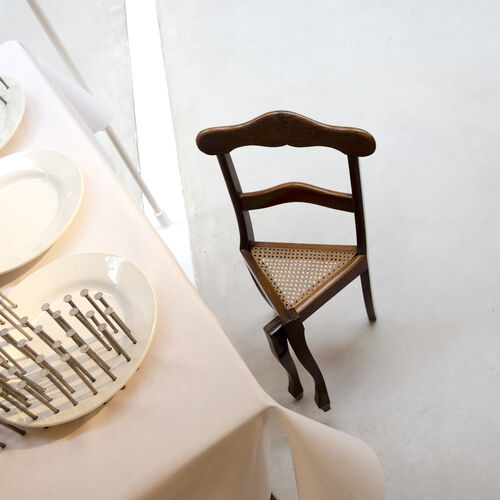
In a world where art collecting can easily be influenced by the opinions of others, Galila Barzilaï’s spirited attitude is as individualized as they come.
Based in Brussels, Galila has been collecting art for two decades, an endeavor that began after the passing of her husband, who was a collector of antiquities. She left Europe to take a short trip to New York and attended The Armory Show, initially assuming that the art fair would be an exhibition of armor— the metal kind, that is.
But what was at first a misunderstanding soon became a source of discovery—and the beginning of her ongoing journey into contemporary art. While there, she acquired her first work: a small, unassuming drawing of the word ‘why?’ repeated 11,522 times by the Canadian artist Tom Fowler. The moment proved poignant: The work was purchased as “an emotional echo to a very painful moment in my life, just a few months after my husband passed away,” she recalled. “Less than half an hour later, I had experienced a sense of rebirth.”
Since then, Galila’s collecting has been led not by trends or fashion but by the artists she encounters and the works she is instinctively drawn to. For her, acquiring art is a deeply personal process that she firmly believes should never be dictated by others. It’s also something that she can’t stop doing. “I am not an art collector,” she told Artsy. “I am an artoholic.”


Faithfully dressed in Issey Miyake and jewellery of her own making, Galila met Artsy at the entrance to her P.O.C. (Passion Obsession Collection) building, south of the Belgian capital. With more than 600 works on view, the space’s walls and floors are filled with a carefully choreographed arrangement of color, concrete, metal, fabric, and photography.
Sitting across from one another with coffee and cake, Galila’s nurturing warmth becomes quickly apparent as she describes her approach to art collecting. “Art is something very abstract,” she told Artsy. “For me, if there’s quality, originality, and creativity—and if I’m touched—then I will consider it. I don’t agree that contemporary art shouldn’t be beautiful, that it shouldn’t have an aesthetic. We are aesthetic.”


Highlights of the collection on view at the P.O.C. include Sans titre (Cadeira de Pernas Cruzadas) (2017) by Luiz Philippe, a series of cross-legged chairs made of wood and natural straw that are redolent of the humor that characterises much of Galila’s collection. Another is Penny Bench (2015) by Dutch-Israeli designer and architect Rolf Bruggink, in which copper pennies are meticulously attached to a metal frame, cleverly mocking modern materials through the inventive use of pocket change. Lucas Simões’s art meets design sculpture Abismo 94 (2018), made of paper, wood, copper, steel, and concrete, carries a playfully futuristic yet foolish quality. Meanwhile, Eugénio Merino’s Ballot Box (2016), crafted from silicone, human hair, envelopes, plexiglass, and iron, acts as a protest against the collapse of democracy, depicting Adolf Hitler’s head filling the box and preventing any fictitious vote from taking place. In Bueiro (Manhole) (2015), the Brazilian artist Vanderlei Lopes transforms polished bronze into something that appears to melt before your eyes, another testament to Galila’s penchant for playfulness and of works that rattle the cage of conformity.
Open to the public by appointment, the P.O.C. is a living, breathing, burping cabinet of curiosities. Like a modern-day salon, it is as much about Galila’s embrace of difference as it is about the ideas of the artists she gathers together. Her intention with the space is to subvert the idea of a static, museum-like collection, instead reimagining it as a living organism. “The collection has become part of my basic needs and reflects who I am,” Galila told Artsy. “Collecting is like psychoanalysis, a self-portrait in a state of permanent construction. Each work I acquire is a new piece of a larger puzzle, gradually composing an image which, I hope, will one day give me a glimpse of my personal truth.”

Walking through the works on view, what emerges is a collection that is as intimate and instinctive as the woman herself. “It’s about passion. It’s evident and embodied in my very being,” she said.
This attitude feeds into the works that Galila opts to purchase. “Buying art is my oxygen, my sustenance, it’s uncontrollable,” she said. “I buy works that speak to me. Most of the time, I don’t know the artist’s name, age, origins, or reputation. I follow my instinct.” Themes such as memory, identity, spirituality, and a gentle mockery of societal structures make for common threads, too.
Her commitment to discovering and supporting emerging artists takes a similarly intuitive approach. The collection includes works by South African artist Chris Soal, who constructs with toothpicks and bottle caps; Dutch sculptor Ram Katzir; the fabric-based pieces of French designer Marion Chopineau; British artist Jonathan Callan, known for his hybrid materiality; and the kinetic sculptures and assemblages of French artist Alice Anderson. Many were purchased before the artists gained wider recognition.

Despite its remarkable breadth, the collection retains its sense of humor and coherence. Galila describes her method as both random and rule-driven. This is exemplified at art fairs, where her ritual is to take a coin and head across the concourse depending on where it falls. “Then I take the map and go from one booth to another, so I know that I’ve seen everything,” she added.
With her collection, Galilais is actively drawing connections through what she purchases and displays. “I prefer to have this kind of dialogue with a piece of art—it makes me understand things from a new point of view,” she noted. IFor that reason, her advice for those beginning to purchase art is simple: don’t overthink it. Let yourself be moved, trust your instincts, and remember—at its most powerful, art is always personal.
from Artsy News https://ift.tt/Dw4Rse2


No comments:
Post a Comment